Language is important. We can all agree on that, right? It helps us communicate meaning so we understand each other. In higher education, we create our own jargon, slang , and acronyms that are supposed to aid in communication and exemplify our culture. Unfortunately, we don’t always stop to confirm that we are talking about the same thing.
Language also changes over time as our environment changes and we develop more nuanced vocabulary or more appropriate verbiage. One example is “extracurricular” and “co-curricular.” On the face of it, they look very similar, but to me can have a very different meaning for college students and those of us who work with college students.
The curriculum is defined as the aggregate of a course of study in school. If you look at the prefix of extracurricular, extra-, it means outside or beyond. In the same vein, the co- in co-curricular means together, jointly, or partnership.
We used to talk about students engaging in extracurricular activities. The tagline of Student Activities used to be “The Other Education.” Looking back, we see that those phrases made it sound like student involvement and engagement were outside of and separate from the learning and education that takes place on a college campus. It was something that wasn’t necessary and valued by others outside of Student Affairs.
Alternatively, we now hear the word co-curricular to mean those experiences that happen alongside or with the curricular, rather than separate from the curricular. Learning takes place all over, regardless if it is in a classroom, residence hall, or a camping tent. We, as student affairs educators, need to continue to embrace the co-curricular as our classroom. In our positions, we have the tremendous opportunity to influence student learning. Many times, as advisors or supervisors, we have one-on-one or small group discussions with students that help them make meaning of their experiences, both in the formal classroom and outside of it. Faculty may not have that luxury when teaching large classes.
There are many examples of how the co-curricular engages students in learning. On the more academic side, experiences such as study abroad and internships provide students with valuable learning experiences. Closer to student affairs work, we see opportunities such as employment, student leadership, and international excursions as tremendous learning experiences. A Resident Advisor (RA), who is also an engineering major, gains skills in teamwork, problem solving, critical thinking, and verbal communication. Those RA skills can be applied to their curricular activities in group projects, presentations, and lab work. Faculty members don’t have the time to teach those “soft skills” but probably expects students to develop them along the way. As advisors and supervisors, we teach those skills and provide real-time feedback that students can use in multiple environments.
Students (should) have one college experience, rather than several siloed experiences. Students should be able to integrate and transfer their learning. As student affairs educators, we should strive to enhance the co-curricular so students have a challenging and rewarding college experience and productive post-graduation life.

